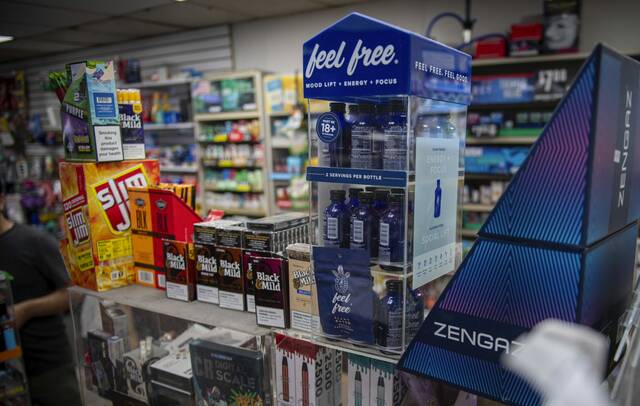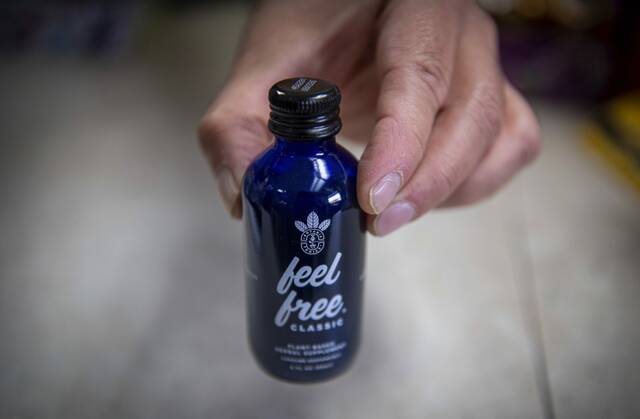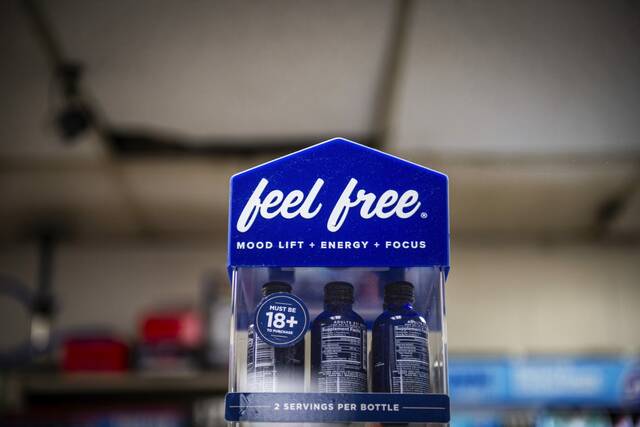What are 'gas station drugs'? Medical professionals warn of addictive effects
Easily found on store shelves, the small blue bottle labeled “Feel Free” is sparking concern as doctors and social media users warn about the dangers of so-called “gas station drugs.”
Manufacturer Botanic Tonics touts the Feel Free drink as a blend of “plant ingredients,” claiming it provides an energy boost and extra focus.
But unsuspecting customers who grab a little blue bottle at a gas station or convenience store soon discover that the kava- and kratom-packed drinks can be highly addictive.
The U.S. Food and Drug Administration has warned people not to use products with kratom because of possible adverse effects such as liver toxicity, seizures and substance use disorder.
“They are a big issue, but they haven’t been really in the crosshairs for a lot of people,” said Dr. Mark Guy, who is part of the addiction medicine team for Allegheny Health Network.
Kava acts as a depressant, while kratom works as a stimulant — giving them opposite effects on the body.
Roisin Sabol, a clinical pharmacist specializing in treatment of substance use disorders at UPMC Western Psychiatric Hospital, said there has been increased concern about Feel Free and similar products containing kratom sold at gas stations. Some stores sell it in capsule or powder form with different names such as Happy Go Leafy and Golden Monk.
Seven states have already banned kratom: Louisiana, Arkansas, Alabama, Indiana, Wisconsin, Vermont and Rhode Island.
Feel Free did not respond to TribLive’s request for comment for several days until after an article posted online Friday.
In a statement, its manufacturer Botanic Tonics said the product does not contain the “concentrated synthetic derivative of kratom,” known as 7-OH and highlighted by the FDA.
“False and misleading statements are being made about Feel Free on social media and are being perpetuated on news outlets,” Botanic Tonics told TribLive Friday.
The most recent viral video warning about Feel Free drinks posted by @yourbestiemisha on TikTok has garnered more than 21 million views and 3 million likes as of Wednesday morning.
@yourbestiemisha WARNING ‼️ Due to the ingredients kratom and kava this seems to be drastically harming people. I didn’t know anything about this and could have easily picked up a bottle sitting on a gas station counter! Be safe ???? #feelfree ♬ original sound - yourbestiemisha
The influencer advised parents and families to be aware of possible adverse effects of the product ahead of the upcoming academic year.
There’s a Reddit page called r/QuittingFeelFree as well.
“This sub is a safe space for people struggling with Feel Free tonic,” the group’s description reads. “It seeks to provide useful information about ways to stop using FF, supplements to support the process, a forum for accountability and a place to share success, struggles and concerns.”
Products containing kratom, sometimes called “gas station drugs” or ‘”gas station heroin,” and their effects snuck up on people, Guy said. They have penetrated countless vape shops and gas stations — including those in Western Pennsylvania. According to the Feel Free store locator on its website, the tonic can be purchased in at least 50 locations in the Pittsburgh area, 20 in the Alle-Kiski Valley area and 45 in Westmoreland County.
Notable places include numerous Sunoco, Exxon, Marathon and BP gas stations across the region. The Staples office supply store at 100 Tarentum Bridge Road in New Kensington even carries the product.
“They are widely available everywhere,” Guy said.
They’re also expensive.
The Feel Free CLASSIC tonic comes in a six-pack for $78 and 12-pack for $157.50, according to its website. For people who sign up for a subscription to the product, it’s $59 for a six-pack and $105 for a 12-pack.
“They have this daily habit that is costing them a couple hundred bucks a week,” Guy said of people who are becoming addicted.
What are ‘gas station drugs’?
Feel Free and other “gas station drugs” are seen as supplements, according to Guy, and they resemble 5-Hour Energy shots in tiny bottles found on the counters of gas stations.
But they are 5-Hour Energy shots “times 10,” he said, and they can become physiologically addictive.
The initial impact of drinking a Feel Free is positive, Guy said, as it can make people feel better with an energy boost. If it’s used more than as needed, though, the result can resemble opioid addiction.
The key ingredients are leaf kratom and kava root. Kratom is a tropical evergreen tree in the coffee family that’s native to Southeast Asia, and kava is used as an herbal remedy and is native to the South Pacific, according to Botanic Tonics, the company that sells Feel Free.
Kratom, however, behaves as an opioid, fitting into opioid receptors in the body when taken, Guy said, because of the chemical 7-hydroxymitragynine, commonly known as 7-OH or 7-Hydroxy.
“It has absolutely undeniable opioid stimulating properties,” he said. “It looks like 7-OH is the chemical, the molecule inside the kratom that is causing the problem.”
The different varieties of gas station drugs can contain varying potencies of 7-OH — with some being on the high end, according to Guy.
“These all get labeled different names, so it’s hard to know which products, and the products can be mixed,” he said. “It is really like the Wild West — there’s no oversight to any of this.”
Aside from kratom, other “gas station drugs” include tianeptine, which is called “gas station heroin” and is found in brands like “ZaZa,” “Tiana” and “Neptune’s Fix,” and phenibut, which is often packaged as a “dietary supplement” or “mood enhancer,” according to the Discovery Place Addiction Recovery Community.
Botanic Tonics said it has sold over 129.7 million servings of feel free and received fewer than 1,000 consumer adverse event complaints total across all categories — with zero complaints involving severe addiction.
In 2023, a class-action lawsuit in California accused Botanic Tonics of falsely advertising its drink as a safe alternative to alcohol.
Sabol said the variability among products is one of her greatest concerns, as it results in people not being fully informed about them. And, she said, marketing or branding on the products can be misleading.
“There can be so much variability from product to product in terms of potency, ingredients,” she said.
Kratom can come in already-mixed products such as Feel Free or in tablets or capsules of powder. The Feel Free brand sells capsules alongside its drinks that are both caffeine-free and naturally caffeinated.
“It’s a little bit like THC in marijuana,” Guy said. “(7-OH is) the psychoactive drug in (kratom).”
About 1.7 million Americans 12 and older used kratom in 2021, according to the Substance Abuse and Mental Health Services Administration’s National Survey on Drug Use and Health in 2021. The FDA cited this statistic in its warning.
As of now, “gas station drugs” are not FDA-controlled, and they’re not labeled as an opioid, according to Guy.
But on July 29, the FDA officially announced it recommended 7-OH be classified as an illicit substance, as it’s a compound with opioid-like effects found in unregulated tablets, gummies and drink mixes at gas stations and convenience stores.
“These molecules can be modified slightly to get past the illicit label but still be psychoactive,” Guy said.
The benefits of gas station drugs containing 7-OH in kratom haven’t been studied in the same rigorous way as other products, according to Sabol.
“Without that confidence and that sort of information available, I can’t recommend them for any particular benefits,” she said.
Staying healthy
Guy said he treated a patient last week who had used kratom for pain management, and two months later that patient was having withdrawal symptoms.
“I have to manage him with medication I have to use for folks hooked on heroin and fentanyl,” he said, referencing buprenorphine or Suboxone, FDA-approved withdrawal medications for treating opioid-use disorder. “It really is such an insidious sort of thing.”
Dependence won’t develop if someone is using kratom sparingly, Guy said, but consistent use can lead to problems.
“If you use it more than 14 days and try to stop it acutely, you’re going to have withdrawal symptoms,” he said.
On the Feel Free website, there’s a message advising people to “consume responsibly.” People should only have one serving, or half of a bottle, at once, and never exceed two servings (one whole bottle) in a 24-hour period.
Guy said Thursday that he has around a dozen patients he is treating with it, but there’s no way of statistically measuring the demographics of who is being affected the most, such as age group or socioeconomic status.
“I think I’m seeing in my addiction medicine practice probably just the tip of the iceberg,” he said. “We just don’t know.”
Sabol said she also has treated a “handful” of patients over the past year who were using substances marketed as kratom, and, like Guy, she sometimes has used buprenorphine to treat those people.
“It varies from person to person, of course,” she said. “There’s no standard protocol or go-to treatment.”
What Guy considers the lead concern in relation to “gas station drugs” is the accessibility of the products to people of all ages.
“You couldn’t buy cigarettes, but you could buy this stuff,” he said. “We don’t let kids come into a bar and buy booze.”
Though the Feel Free website, for example, asks internet users whether they are 21 or older before entering the site, the only test buyers must pass on the website to snag some Feel Free drinks is clicking an “Age Consent” box during the checkout process.
At the In & Out Corner Market on Penn Avenue in Bloomfield, people can purchase Feel Free drinks if they are 18 or older, a TribLive reporter observed.
Guy said he believes at some locations people of any age can purchase “gas station drugs” without any identification.
“You gotta be open, sit down with kids. I would have those conversations with them and kind of just be vigilant,” he said.
It’s very important to be aware of warning signs indicating use of any substances that can be used in nonmedical ways, Sabol said, especially with kratom because it’s so ubiquitous.
Some indicators can include anxiety, seizures, respiratory depression and slowed breathing, but she said these are the worst and most dangerous cases.
“It is difficult to characterize because of lack of data or lack of standardized tracking until more recently,” Sabol said.
The National Poison Data System only began tracking 7-OH in February, she said.
Megan Swift is a TribLive reporter covering trending news in Western Pennsylvania. A Murrysville native, she joined the Trib full time in 2023 after serving as editor-in-chief of The Daily Collegian at Penn State. She previously worked as a Jim Borden Scholarship intern at the Trib for three summers. She can be reached at mswift@triblive.com.
Remove the ads from your TribLIVE reading experience but still support the journalists who create the content with TribLIVE Ad-Free.



